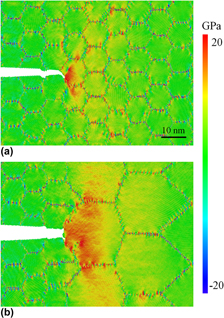Crossref Citations
This article has been cited by the following publications. This list is generated based on data provided by
Crossref.
Yu, M.
Fang, Q. H.
Feng, H.
and
Liu, Y. W.
2016.
Effect of special rotational deformation on dislocation emission from interface collinear crack tip in nanocrystalline bi-materials.
Acta Mechanica,
Vol. 227,
Issue. 7,
p.
2011.
Wang, Peng
Yang, Xinhua
and
Peng, Di
2017.
Molecular dynamics investigation of the grain boundary migration hysteresis of nanocrystalline Ni under cyclic shear loading.
Modelling and Simulation in Materials Science and Engineering,
Vol. 25,
Issue. 2,
p.
025006.
Vorotilo, S.
Levashov, E.A.
Kurbatkina, V.V.
Kovalev, D.Yu.
and
Kochetov, N.A.
2018.
Self-propagating high-temperature synthesis of nanocomposite ceramics TaSi2-SiC with hierarchical structure and superior properties.
Journal of the European Ceramic Society,
Vol. 38,
Issue. 2,
p.
433.
Zhou, Kai
Zhang, Ting
Liu, Bin
and
Yao, Yijun
2018.
Molecular dynamics simulations of tensile deformation of gradient nano-grained copper film.
Computational Materials Science,
Vol. 142,
Issue. ,
p.
389.
Vorotilo, Stepan
Potanin, Artem Y.
Iatsyuk, Ivan V.
and
Levashov, Evgeny A.
2018.
SHS of Silicon‐Based Ceramics for the High‐Temperature Applications.
Advanced Engineering Materials,
Vol. 20,
Issue. 8,
Huang, Sixie
Wang, Jian
and
Zhou, Caizhi
2018.
Deformation of Heterogeneous Nanocrystalline Lamella with a Preexisting Crack.
JOM,
Vol. 70,
Issue. 1,
p.
60.
Yu, Min
Yang, Yuxuan
Peng, Xianghua
and
Wen, P.H.
2018.
Effect of nanotwin and dislocation pileup at twin boundary on dislocation emission from a semi-elliptical blunt crack tip in nanocrystalline materials.
Engineering Fracture Mechanics,
Vol. 202,
Issue. ,
p.
288.
Yu, M.
Peng, X. H.
and
Wen, P. H.
2018.
Effect of cooperative grain boundary sliding and migration on dislocation emission from interface collinear crack tip in nanocrystalline bi-materials.
Acta Mechanica,
Vol. 229,
Issue. 9,
p.
3901.
Potanin, A.Yu.
Vorotilo, S.
Pogozhev, Yu.S.
Rupasov, S.I.
Lobova, T.A.
and
Levashov, E.A.
2019.
Influence of mechanical activation of reactive mixtures on the microstructure and properties of SHS-ceramics MoSi2–HfB2–MoB.
Ceramics International,
Vol. 45,
Issue. 16,
p.
20354.
Li, Xiaotao
Zhao, Jianfeng
Zhang, Xu
and
Jiang, Xiaoyu
2019.
Revealing the inhibition mechanism of grain size gradient on crack growth in gradient nano-grained materials.
International Journal of Solids and Structures,
Vol. 172-173,
Issue. ,
p.
1.
Sun, Jia
Ye, Hongfei
Tao, Jun
Li, Qian
Zhang, Jiayong
Shen, Luming
Zheng, Yonggang
and
Zhang, Hongwu
2019.
Gradient structure regulated plastic deformation mechanisms in polycrystalline nanotwinned copper.
Journal of Physics D: Applied Physics,
Vol. 52,
Issue. 36,
p.
365304.
Zhang, Zhennan
Yang, Fan
Liu, Yaping
and
Wang, Lihua
2020.
J-integral evaluation of a mode I crack in gradient nanocrystalline metals.
Materials Today Communications,
Vol. 25,
Issue. ,
p.
101328.
Peng, Xianghua
Yu, Min
and
Liu, Youwen
2020.
Effect of nanotwin and dislocation pileup at twin boundary on dislocation emission from an interfacial collinear crack tip in nanocrystalline bimaterials.
Mechanics of Advanced Materials and Structures,
Vol. 27,
Issue. 12,
p.
965.
Liu, Ya Ping
and
Yang, Fan
2020.
Numerical Study of Fracture Behavior of Gradient Nano-Grained Metals by Molecular Dynamics Simulations.
Key Engineering Materials,
Vol. 843,
Issue. ,
p.
99.
Liu, Yaping
Yang, Fan
and
Zhang, Jiarui
2020.
Effects of the grain size gradient on the microstructural evolution in gradient nano‐grained copper with initial central crack.
Material Design & Processing Communications,
Vol. 2,
Issue. 3,
Lin, Yan
Yu, Qin
Pan, Jie
Duan, Fenghui
Ritchie, Robert O.
and
Li, Yi
2020.
On the impact toughness of gradient-structured metals.
Acta Materialia,
Vol. 193,
Issue. ,
p.
125.
Wei, Ning
Zhao, Si-Han
Li, Zhi-Hui
Ou, Bing-Xian
Hua, An-Ping
and
Zhao, Jun-Hua
2022.
Effects of graphene size and arrangement on crack propagation of graphene/aluminum composites.
Acta Physica Sinica,
Vol. 71,
Issue. 13,
p.
134702.
Feng, Yan
Li, Jie
and
Yang, Xinhua
2022.
Intragranular and Intergranular Crack Propagation in Nanocrystalline Ni Under Single-Cycle Mode I Loading.
Metals and Materials International,
Vol. 28,
Issue. 7,
p.
1590.
Chen, Xiang
Li, Shuang
Tang, Xiao
Lu, Sheng
Zhao, Yang
Fu, Tao
and
Peng, Xianghe
2022.
Molecular dynamics analysis of the low-temperature shock behavior of the CoCrFeMnNi high-entropy alloy.
Modelling and Simulation in Materials Science and Engineering,
Vol. 30,
Issue. 8,
p.
085006.
Liu, Yaping
Yang, Fan
Zhang, Xiang
Zhang, Jiarui
and
Zhong, Zheng
2022.
Crack propagation in gradient nano-grained metals with extremely small grain size based on molecular dynamic simulations.
International Journal of Fracture,
Vol. 233,
Issue. 1,
p.
71.





